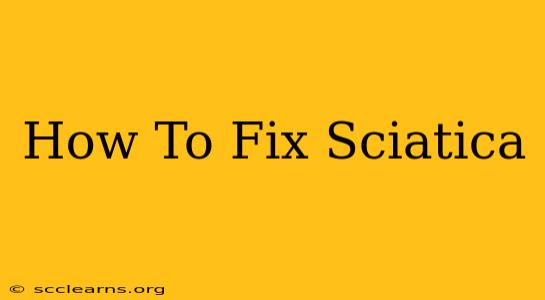Sciatica, that sharp, shooting pain radiating down your leg, can be debilitating. But before you resign yourself to a life of discomfort, know that there are effective ways to manage and even fix sciatica. This comprehensive guide explores various approaches to alleviate your pain and regain your mobility.
Understanding Sciatica: What Causes This Nerve Pain?
Sciatica isn't a condition itself, but rather a symptom of an underlying issue, most commonly a compressed or irritated sciatic nerve. This nerve, the longest in the body, runs from your lower back, through your hips and buttocks, and down each leg. Compression can stem from several sources:
- Herniated Disc: A bulging or ruptured disc in your spine can put pressure on the sciatic nerve.
- Spinal Stenosis: Narrowing of the spinal canal can also impinge on the nerve.
- Spondylolisthesis: This is where one vertebra slips forward over another, potentially compressing the nerve.
- Piriformis Syndrome: This involves irritation of the sciatic nerve by the piriformis muscle, located in the buttock.
- Pregnancy: The added weight and hormonal changes during pregnancy can exacerbate sciatica.
Effective Strategies to Fix Sciatica: A Multi-Pronged Approach
Addressing sciatica requires a holistic approach combining various strategies. Here's a breakdown of effective methods:
1. Conservative Treatments: The First Line of Defense
Before considering more invasive procedures, conservative treatments are often the first step. These include:
- Over-the-counter pain relievers: Ibuprofen or naproxen can help reduce inflammation and pain.
- Rest and ice: Resting the affected area and applying ice packs can decrease inflammation. Important: Don't stay completely inactive; gentle movement is crucial.
- Heat therapy: Applying heat can relax muscles and ease pain. Experiment to see whether heat or ice works best for you.
- Physical therapy: A physical therapist can design a personalized exercise program to strengthen your core muscles, improve flexibility, and alleviate pressure on the nerve. Exercises often focus on stretches for the lower back, hamstrings, and hips.
- Chiropractic care: Chiropractic adjustments aim to realign the spine and reduce nerve compression.
2. Lifestyle Modifications for Long-Term Sciatica Relief
Making sustainable lifestyle changes can significantly impact sciatica management:
- Maintain a healthy weight: Excess weight puts extra stress on your spine.
- Ergonomic improvements: Ensure proper posture at work and at home. Consider using ergonomic chairs and adjusting your workstation.
- Regular exercise: Engage in low-impact exercises like swimming, walking, or yoga to strengthen your core and improve flexibility. Avoid high-impact activities that could aggravate your sciatica.
3. Medical Interventions: When Conservative Treatments Fail
If conservative methods fail to provide relief, your doctor might recommend:
- Corticosteroid injections: These injections can reduce inflammation around the sciatic nerve.
- Epidural steroid injections: These injections are administered into the epidural space surrounding the spinal cord to reduce inflammation and pain.
- Surgery: Surgery is usually considered a last resort when other treatments have been unsuccessful. Surgical options aim to correct the underlying cause of nerve compression, such as removing a herniated disc.
When to See a Doctor for Sciatica
It's crucial to consult a doctor if your sciatica pain:
- Is severe or debilitating.
- Is accompanied by weakness, numbness, or bowel/bladder dysfunction.
- Doesn't improve with home remedies after a few weeks.
Disclaimer: This information is intended for educational purposes only and should not be considered medical advice. Always consult with a healthcare professional before starting any treatment for sciatica. They can properly diagnose the underlying cause of your pain and recommend the most appropriate course of action. They will be able to provide personalized recommendations based on your specific situation and medical history. Self-treating can be risky, and professional medical guidance is always best.

